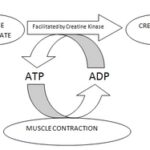The plasma membrane is a barrier separating the cell from it’s surroundings. Plasma membranes are semi-permeable, meaning that they allow the passage of some substances through the membrane, while prohibiting the passage of other substances. The methods of transporting substances through the plasma membrane are either passive or active and carrier-mediated or not. Passive transport does not consume any ATP, while active transport does. Carrier-mediate mechanisms utilize a protein to assist in the transportation of substances through the membrane.
Filtration
Filtration is a passive method of transport in which substances are driven through the membrane hydrostatic pressure. The pressure of the water drives dissolved substances through a filter, allowing smaller particles to pass through, while larger particles are not permitted entry into the cell.
Simple Diffusion
Simple diffusion involves the movement of particles from an area of high concentration to an area of low concentration. When the concentration of a substance differs from one point to another, it is said that the substance exhibits a concentration gradient. Diffusion occurs quickly and easily in mediums such as air and water, and a membrane isn’t always necessary. There are a few factors that may affect the rate of diffusion in a substance; temperature, molecular weight, steepness, membrane surface area and membrane permeability. Substances that are warmer or of a lighter molecular weight are more easily diffused. The steepness, or difference in concentration, also allows easier diffusion; the greater the difference in concentration, the easier substances diffuse. Membranes with a larger surface area our more conducive to diffusion as there is a larger area available for substances to pass through. Lastly, the more permeable a membrane is, the easier substances are able to diffuse through it.
Osmosis
Osmosis involves the transport of water molecules from one side of a selectively permeable membrane to the other. The direction of transport is typically from the side of the membrane with the highest concentration of water molecules to the side of the membrane with the lower concentration of water molecules. Reverse osmosis occurs by a mechanical process in which water is forced through a membrane against it’s typical concentration gradient. Cells can increase the speed of osmosis by creating more aquaporins, or proteins that specifically allow for the passage of water.
Osmolarity & Tonicity
Osmolality is measured by the amount of osmoles of a particular solute per kilogram of solution where osmolarity is the number of osmoles per liter of a solution. In laboratory settings, calculations are usually based on osmolarity.
Tonicity is the ability of a solution to impact the volume and pressure within a cell. A hypotonic solution has a lower concentration of non-permeating substances. Cells in a hypotonic solution absorb water and may swell and burst. A hypertonic solution has a higher concentration of non-permeating solutes. A cell in a hypertonic solution will shrivel and lose water. An isotonic solution contains an equal number of permeable solutes as in the intracellular fluid. A cell in an isotonic solution with neither swell nor shrivel.
Carrier-Mediated Transport
Some methods of transport require a cell membrane, and transport efforts may be aided by what are known as carriers. Carriers exhibit specificity, meaning a carrier is designed for the transport of a specific substance. Carriers also exhibit what is known as saturation, an increase in the rate of transport as the concentration of a solute rises. When the transport maximum has been met there are no more carriers able to handle excess substances.
There are three types of carriers; uniports, symports and antiports. A uniport is capable of carrying only a single solute at once. A symport is capable of carrying two or more solutes simultaneously in the same direction. This process is known as costransport. An antiport carries two or more solutes in opposite directions. This is known as countertransport.
There are two mechanisms that carriers use; facilitated diffusion and active transport. Facilitated diffusion involves the transport of a solute down the concentration gradient and does not consume ATP. Active transport involves the transport of a solute up the concentration gradient and consumes ATP.
References
Saladin, Kenneth S.. Anatomy & physiology: the unity of form and function. 5th ed. Dubuque: McGraw-Hill, 2010. Print.
Osmosis
Facilitated Diffiusion
Tonicity & Osmolarity
Transport Across Cell Membranes



